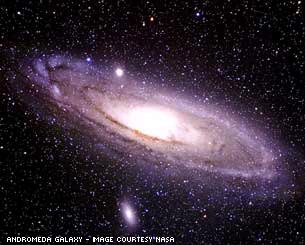Hand-Crank Generator DIY STEM Kit
$9.99$6.50
 Distances to deep-sky objects such as the Andromeda galaxy are often determined using what are referred to as "Standard Candles", which means that astronomers look for objects located within the target for which they believe they know the intrinsic luminosity (how bright it actually is).
For any light-emitting object, it's apparent luminosity (how bright it appears to us) decreases with the square of the distance between the object and the observer; so, if we know the intrinsic luminosity of an object, we can measure the apparent luminosity and perform a straightforward calculation to obtain the approximate distance to the object.
An example of such a "Standard Candle" are what are called Cepheid Variable stars. These are young, massive, bright stars (about 1000 times more luminous than our Sun) that undergo periodic changes in luminosity. It has been found that the period of the Cepheid variable is related to its intrinsic brightness, such that if one measures how often the star changes luminosity, one can calculate its intrinsic luminosity, thus allowing the distance to the Cepheid variable to be calculated.
Another commonly used "Standard Candle" is a type of supernova, called a Type Ia supernova, caused by the collapse of a white dwarf star that has been stealing mass from a companion star.
Astronomers believe that all Type Ia supernovas have approximately the same peak intrinsic luminosity (about -19.5). Again, since the intrinsic luminosity is known, a measurement of the apparent luminosity allows a calculation of the approximate distance to the supernova. Also, since supernovas are so incredibly bright, they can be observed over vast distances, making them ideal for measurements involving objects much further away than the Andromeda galaxy (ie. billions of light-years).
Distances to deep-sky objects such as the Andromeda galaxy are often determined using what are referred to as "Standard Candles", which means that astronomers look for objects located within the target for which they believe they know the intrinsic luminosity (how bright it actually is).
For any light-emitting object, it's apparent luminosity (how bright it appears to us) decreases with the square of the distance between the object and the observer; so, if we know the intrinsic luminosity of an object, we can measure the apparent luminosity and perform a straightforward calculation to obtain the approximate distance to the object.
An example of such a "Standard Candle" are what are called Cepheid Variable stars. These are young, massive, bright stars (about 1000 times more luminous than our Sun) that undergo periodic changes in luminosity. It has been found that the period of the Cepheid variable is related to its intrinsic brightness, such that if one measures how often the star changes luminosity, one can calculate its intrinsic luminosity, thus allowing the distance to the Cepheid variable to be calculated.
Another commonly used "Standard Candle" is a type of supernova, called a Type Ia supernova, caused by the collapse of a white dwarf star that has been stealing mass from a companion star.
Astronomers believe that all Type Ia supernovas have approximately the same peak intrinsic luminosity (about -19.5). Again, since the intrinsic luminosity is known, a measurement of the apparent luminosity allows a calculation of the approximate distance to the supernova. Also, since supernovas are so incredibly bright, they can be observed over vast distances, making them ideal for measurements involving objects much further away than the Andromeda galaxy (ie. billions of light-years).